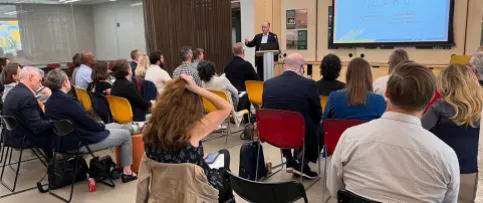The opinions expressed in this commentary are solely those of the author and do not necessarily reflect those of the National Council of Architectural Registration Boards (NCARB).
The University of Massachusetts Amherst Department of Art, Architecture, and Art History was one of three architecture programs selected as a recipient of the 2013 NCARB Award. The school's proposal, “Voices from the Field: From Design Concept to Reality,” was awarded $25,000 for developing innovative curricula that merge practice and education. We caught up with Assistant Professor of Architecture Caryn Brause, AIA, LEED AP, for an update on the winning entry.
The Department of Architecture at UMass Amherst provides an accessible, intellectually rigorous design education that firmly grounds students in the art and science of the built environment. The NCARB Award is meaningful to us as we continue to develop our young program. We were first accredited in 2005, so we are still honing and shaping our unique approach to education.
Through the NCARB Award, we’re developing a new experiential seminar entitled “Voices from the Field.” The project is a response to the 2012 Practice Analysis of Architecture, which strongly recommended integrating fieldwork into the academic curriculum to establish an early understanding of construction sequences. The course is structured to provide an opportunity for students to learn about the relationship between concept and technical design, to develop an understanding of construction processes, and to become familiar with the architect’s role from design to construction and maintenance. Through the course, students gain unique exposure to the nuances of the construction process by first reviewing project documentation and then going on a series of construction site visits.
The course examines active building projects in our region, Western Massachusetts, and on the UMass Amherst campus. The course got off to a strong start during this past spring 2014 semester. We went on seven construction site visits to five different high-performance building projects, including two university sports facilities, an academic classroom building, an environmental center, and a multi-family housing complex. Touring the construction sites and discussing the projects with architects, contractors, engineers, and facilities managers demonstrated to students how architects make decisions regarding sustainable design issues including building materials and construction processes.
Students wrote culminating essays synthesizing their experiences. This is one way we are gauging the effectiveness of the course and honing future iterations.
“As a student with little experience on construction job sites, I found the spring 2014 Voices in the Field course to be very informative,” wrote 2014 Master of Architecture student Samantha Greenberg. “It was particularly useful to examine projects of varying scale and scope; to meet with designers, project managers, and contractors; and to visit buildings in various stages of construction and occupancy.”
We had the great fortune to visit the Bechtel Environmental Classroom, the fifth registered building in the Living Building Challenge, with our non-faculty practitioner, Bruce Coldham. Student Yi Wang wrote of this project, “Without exaggeration I would claim that Bechtel exerts the greatest influence on my plans for my future career. From the drawings we can see that Bruce and his team members devoted a lot of energy and care to this project, which causes me to reflect on the responsibility of the architect. To create a healthy interior environment, they have spent a lot of time looking for appropriate substitutes and taking them into account in this design.”
The non-faculty practitioners included those practicing at small firms, large firms, and university facilities departments. They ranged from a recent graduate, who is now an intern, to deeply experienced architects. Engaging a diverse group of non-faculty practitioners demonstrated different practice models and offered insights into the professional conduct issues that arise in manifold professional situations. Additionally, these site visits offered the 15 advanced graduate students an opportunity to see the breadth of the field, enabling them to envision the different types of roles they could imagine for themselves when they graduate and go off to practice.
“Clearly, there is an incredible difference between the schematic design process typical in architecture studio courses compared to the actual depth and rigor that is required to execute design and construction of a real-world project,” wrote 2015 Master of Architecture student Rachel Beesen. “Before taking this course, I did not fully understand the relationship and transitions between design and construction. I now see that these relationships and transitions are vital parts of the process of creating a building, just as important as design.”


